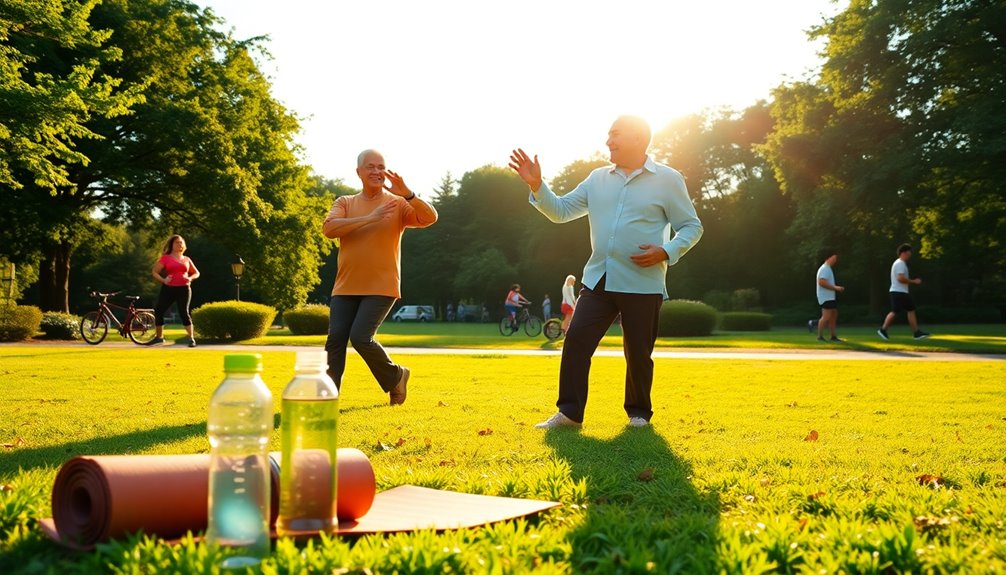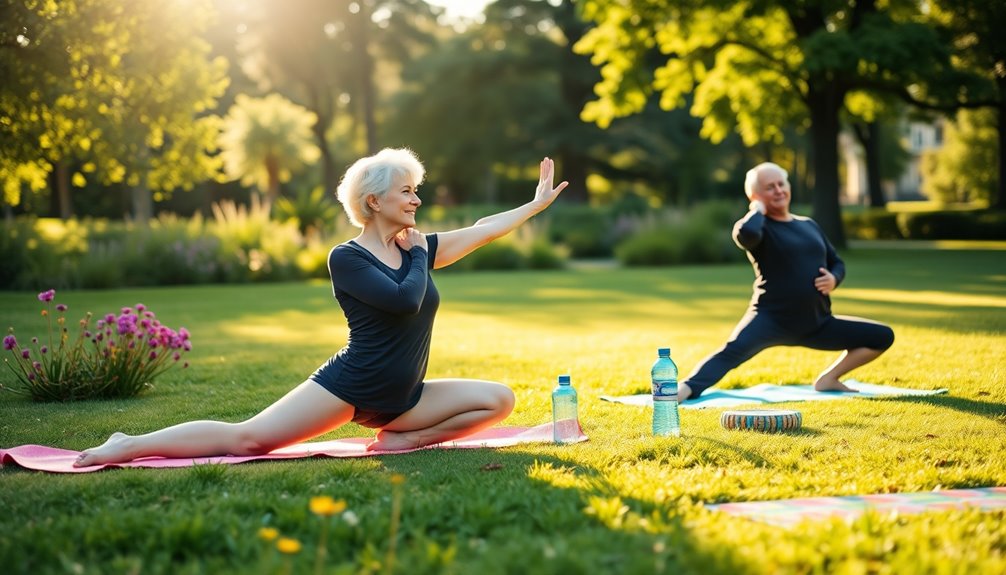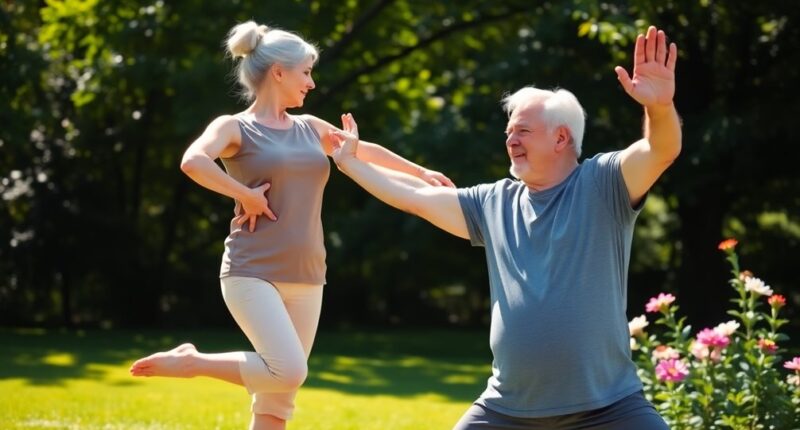To stay active and injury-free as you age, listen to your body and know your injury history. Set a comfortable pace, gradually increasing your activity while incorporating rest days. Define clear fitness goals that reflect your current abilities and engage in prevention strategies tailored to your workouts. Explore low-impact alternatives and prioritize stretching and recovery techniques. Maintaining hydration and proper nutrition is essential too. There's more to uncover on how to maximize your fitness safely as you age.
Key Takeaways
- Listen to your body and adjust workouts based on sensations to prevent long-term injuries.
- Engage in consistent rehabilitation exercises to strengthen previously injured areas and maintain mobility.
- Set clear, measurable fitness goals and regularly review them to align with your current capabilities.
- Incorporate low-impact activities like swimming or yoga to improve flexibility and reduce injury risk.
- Prioritize recovery with stretching, hydration, and active recovery days to support muscle repair and overall health.
Listen to Your Body

As you age, listening to your body becomes vital for staying active and injury-free. When you tune in to how your body feels, you can identify discomfort or pain early, helping you avoid exacerbating existing injuries.
Pay special attention to sensations in vulnerable areas like your knees or back; this awareness will guide you in modifying your exercise routine to prevent injury. Remember, it's important to adjust your workout intensity based on your body's signals.
Pushing through pain might seem admirable, but it can lead to long-term damage. Also, keep track of previous injuries, as this knowledge can influence safer exercise choices and promote recovery. Additionally, incorporating effective relaxation techniques can help manage stress and improve overall well-being.
Prioritizing your body's signals will help you stay active for years to come.
Know Your History

Knowing your history of previous injuries is key to staying safe while staying active.
It's important to keep up with rehabilitation exercises and track your recovery progress to strengthen vulnerable areas. Additionally, understanding the psychology behind cravings can help you recognize any emotional triggers that might lead to overexertion or injury.
Previous Injuries Awareness
Understanding your injury history is essential for staying active and injury-free as you age. Previous injuries awareness helps you recognize areas needing extra caution, reducing your risk for injury. By maintaining proper form and monitoring your recovery progress, you can tailor your exercise regimen to avoid movements that may aggravate old injuries. Engaging in safe, durable toys can also promote physical activity in a fun and safe manner, which is beneficial for maintaining overall fitness.
| Previous Injury | Precautions Needed | Recommended Exercises |
|---|---|---|
| Ankle Sprain | Strengthen ankle muscles | Balance exercises |
| Knee Injury | Avoid deep squats | Low-impact cardio |
| Shoulder Strain | Limit overhead lifts | Resistance band work |
Rehabilitation Exercises Importance
Rehabilitation exercises play an essential role in your journey to stay active and injury-free as you age, especially if you've experienced previous injuries.
These exercises help strengthen previously injured areas, reducing the risk of re-injury and promoting overall physical health. By consistently engaging in rehabilitation exercises, you can maintain mobility and improve balance, both of which tend to decline with age.
Incorporating these routines into your life allows you to regain pre-injury strength levels, enhancing functional movement and greatly impacting your quality of life.
Plus, adhering to a rehabilitation program can prevent compensatory movement patterns that lead to further injuries. Additionally, understanding routine health checks can be beneficial in identifying potential issues before they escalate.
Recovery Progress Tracking
While you may think of recovery as simply getting back to your routine, tracking your progress can be a game-changer in staying active and injury-free.
By maintaining a record of your previous injuries and rehabilitation exercises, you provide essential information to healthcare providers, ensuring tailored care for injury prevention.
Regularly evaluating your recovery progress helps you recognize patterns in your physical responses, allowing you to adjust workout intensity as needed.
Keeping a journal of your workout sensations and recovery times fosters a proactive approach to understanding your limits and risk areas.
Learning from your past experiences and adapting your training regimens based on documented recovery progress can greatly enhance both your safety and performance in pursuing an active lifestyle.
Additionally, understanding your financial responsibilities, such as credit card debt management, can help reduce stress and allow for a greater focus on your physical wellbeing.
Set Your Pace

Setting your pace is essential for maintaining an active lifestyle as you age, especially when it comes to preventing injuries. Start by gradually increasing your activity level, following the 10% rule, which limits your weekly distance or intensity increase to avoid overuse injuries.
Always begin workouts with a 5-10 minute warm-up to prepare your muscles and joints, enhancing your mobility and flexibility. During workouts, start at a comfortable pace to gauge your body's response, allowing for necessary adjustments.
Incorporate rest days and avoid repetitive motions to prevent strain, especially after strength training. Balancing your activity intensity with your current fitness level guarantees that your routine remains both challenging and safe, helping you stay active without risking injury. Maintaining a clean home can also support your physical activity by creating a safe and organized environment, free of hazards that could lead to falls.
Define Your Goals

To stay active and injury-free as you age, it's essential to set clear fitness objectives. Regularly tracking your progress helps you see how far you've come, while adjusting your goals guarantees they remain realistic and relevant. Additionally, focusing on self-acceptance can enhance your overall well-being and support your fitness journey.
Set Clear Objectives
Clear fitness objectives can greatly boost your motivation and provide a sense of direction as you age. By setting clear objectives, you're more likely to stay committed to your exercise routine.
Aim for specific goals, like achieving 150 minutes of moderate-intensity activity each week, which can guide your workout plans and guarantee balanced physical activity. You might also focus on measurable objectives, such as improving your balance by practicing standing on one leg for 30 seconds.
Consulting with a personal trainer or healthcare provider can help tailor your fitness objectives to your capabilities, ultimately helping reduce the risk of injury. Establishing a routine can also provide stability through rules that promotes consistency in your fitness journey.
Regularly reviewing and updating your goals as your physical condition changes will keep you on track and promote peak health.
Track Progress Regularly
Tracking your progress regularly is essential for staying motivated and ensuring your fitness journey remains effective. By setting specific, measurable, achievable, relevant, and time-bound (SMART) goals, you create clear milestones that help you stay committed.
Use a workout journal or fitness apps to monitor your activity levels and gradually increase intensity, adhering to the 10% rule to avoid injury. Reviewing your progress every few weeks keeps your routine aligned with your evolving fitness levels and health needs.
Don't hesitate to seek medical advice or share your goals with a fitness professional, as their feedback can enhance your safety and effectiveness. Regular tracking not only celebrates improvements but also reinforces your dedication to a healthier lifestyle. Additionally, understanding your IRA investment strategy can provide you with the financial security needed to support your active lifestyle as you age.
Adjust Goals as Needed
As you age, it's important to set realistic fitness objectives that reflect your current capabilities and health status. By regularly evaluating your progress, you can adjust goals as needed to accommodate any injuries or limitations. This guarantees you stay active while minimizing the risk of further issues.
Consider seeking professional guidance from trainers or coaches who can help you establish age-appropriate targets tailored to your individual needs. Creating a progressive workout plan that gradually increases in intensity allows you to strengthen your body safely. Keep track of your achievements, no matter how small, to reinforce your commitment to maintaining an active lifestyle. Additionally, incorporating emotional regulation techniques can enhance your motivation and focus throughout your fitness journey.
Tailor Prevention to Your Workout

To stay active and injury-free, it's vital to tailor your prevention strategies to the specific workouts you engage in. Different activities carry unique injury risks; for instance, jogging can lead to knee and foot issues, so wearing supportive footwear is essential.
If you're circuit training, prioritize rest and recovery to avoid shoulder injuries. High-impact sports like football and tennis require careful assessment of your physical condition, especially as bone density and flexibility decrease with age.
Incorporating cross-training into your routine helps prevent muscle overuse injuries by targeting various muscle groups. Consulting with sports medicine professionals can further enhance your tailored prevention strategies, ensuring you remain safe and effective in your fitness journey.
Find Alternatives

Finding alternatives in your workout routine can greatly enhance your ability to stay active while minimizing injury risks.
Explore low-impact activities like swimming, cycling, and walking to keep your heart healthy without straining your joints. Incorporate exercises such as tai chi or yoga, which are excellent for improving flexibility and balance while reducing the chances of injury.
Cross-training can also be beneficial; mixing different workouts helps prevent muscle overuse and promotes overall strength. Aim to include resistance training with light weights or resistance bands a couple of times a week to build strength without high impact.
Additionally, use stability tools like balance boards to enhance coordination and balance, essential as you age.
Learn Your Stretches

Understanding the importance of stretching can make a significant difference in your overall fitness routine. Incorporating the right stretches can help you maintain flexibility and prevent injuries as you age.
| Stretch Type | Purpose | Example Exercises |
|---|---|---|
| Dynamic Stretches | Warm up muscles | Leg swings, arm circles |
| Static Stretches | Improve flexibility | Hamstring, quadriceps |
| Foam Rolling | Alleviate muscle tension | Myofascial release |
| Targeted Stretches | Address tight muscle groups | Hip, back, shoulder stretches |
| Pain Management | Modify stretches as needed | Listen to your body |
Prioritize Recovery

Maintaining flexibility through stretching is just one part of an effective fitness routine as you age.
Prioritizing recovery is essential for older adults, as it helps you reduce the risk of injuries and supports muscle repair after physical activity. Incorporate active recovery days with light walking or gentle stretching to enhance your overall recovery and prevent stiffness.
Make sure to allow at least 48 hours between strength training sessions targeting the same muscle groups, promoting ideal healing and avoiding overuse injuries.
Don't forget hydration—drink about one-third of your body weight in ounces of water daily to support muscle function.
Techniques like foam rolling or gentle yoga can also improve blood flow, reduce muscle tension, and enhance your flexibility and mobility.
Frequently Asked Questions
How Can You Prevent Injuries as You Get Older?
To prevent injuries as you get older, focus on warming up and cooling down properly.
Incorporate strength training into your routine at least twice a week to preserve muscle mass. Engage in low-impact activities like swimming or cycling to ease joint strain.
Stick to the 10% rule by gradually increasing your exercise intensity and duration.
Finally, practice balance exercises regularly to enhance coordination and reduce fall risk. Your body will thank you!
How Do You Stay Physically Active as You Age?
As you age, staying physically active can feel intimidating. But it doesn't have to be!
Start by setting a goal of 150 minutes of moderate exercise each week; brisk walking is a great choice. Add in strength training twice a week to keep your muscles strong.
Don't forget balance exercises—just standing on one foot can make a difference. Choose low-impact options like swimming to protect your joints while keeping fit.
At What Age Do Physical Abilities Begin to Decline?
Physical abilities typically start to decline around age 30.
You might notice a gradual decrease in muscle mass, about 3-5% per decade.
By age 40, your aerobic capacity and cardiovascular health could begin to wane, impacting your endurance.
Flexibility and joint mobility often diminish after 50, increasing stiffness and injury risks.
As you reach 60, you may experience a notable decrease in balance and coordination, raising the chances of falls.
How Can I Exercise and Be Injury Free?
To exercise and stay injury-free, start with a warm-up and cool-down that includes light aerobic activity and stretching.
Follow the 10% rule when increasing your activity levels to prevent overexertion.
Mix up your routine with low-impact exercises like swimming or cycling at least twice a week, and prioritize strength training for major muscle groups.
Listen to your body and adjust your workouts if you feel any pain or discomfort.
Conclusion
As you journey through life like a seasoned traveler, remember to tune in to your body's whispers and adjust your pace accordingly. Each step you take is a brushstroke on the canvas of your wellbeing. By setting realistic goals and embracing recovery, you're not just avoiding injury; you're painting a vibrant picture of resilience. Celebrate your unique path, explore alternatives, and let your commitment to staying active be the masterpiece that inspires others on their journeys.









